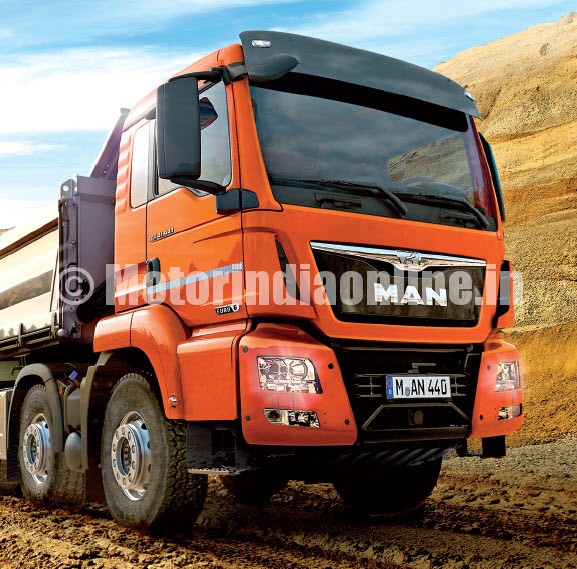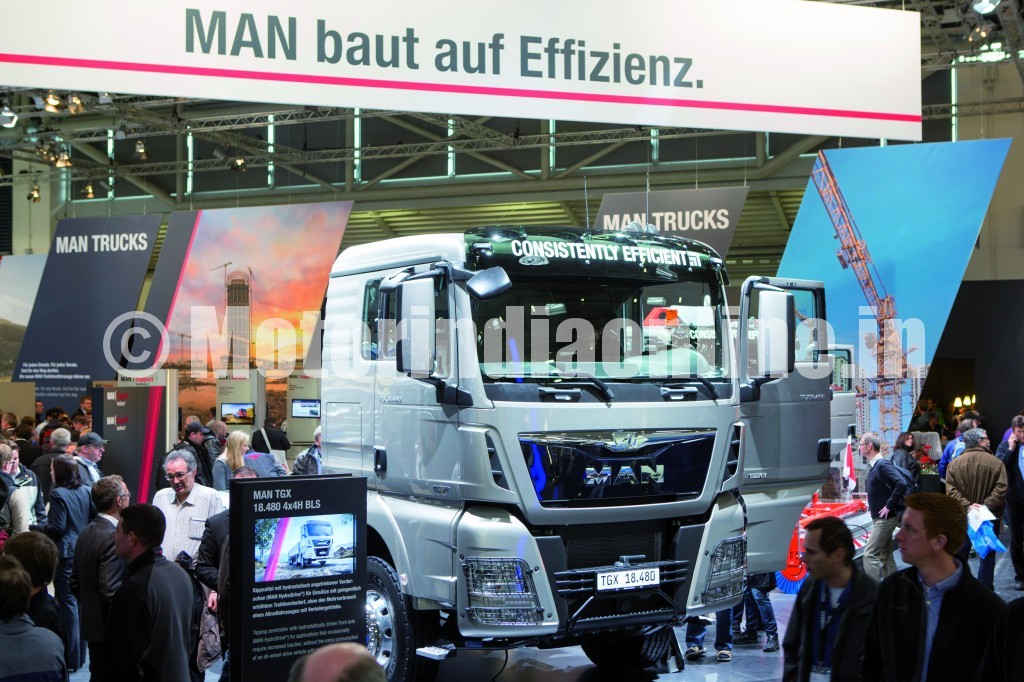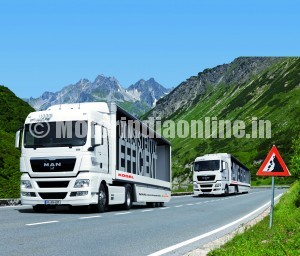
Under the motto “Consistently efficient”, the new Euro VI vehicles for traction transport were in the limelight at MAN’s bauma stand. MAN has been producing all-wheel-drive vehicles for over 75 years, and its competence in this segment and knowledge of the industry are unmatched.
At the show, MAN engines complying with the Euro VI exhaust standard celebrated their world premiere in construction vehicles. Further innovations were cabs with steel bumpers, the crew cab for the MAN TGL and TGM series and a heavy-duty four-axle tipper with a gross weight of 50 tonnes for operation in open-cast mining.
For many decades now, MAN has been a strong partner for the construction industry. At the trade fair, customers saw MAN construction vehicles complying with the Euro VI standard and combining economy with reliability. The focus was on efficient construction logistics with rugged and economical vehicles and a comprehensive portfolio of services.
The new MAN TGS and TGX models showed themselves with a completely newly designed front end boasting a harmoniously integrated steel bumper. The TGL series with conventional on-road drive and the TGM series with on-road as well as all-wheel drive are both available with the new three-piece steel bumper.
Customers responded very positively to the new interior design of the MAN TGL and TGM when the on-road versions were introduced. It offers more comfort and functionality, thanks to the high-quality finish and easy-to-use instruments.
MAN rounded off its appearance at the trade fair with the presentation of its re-engineered crew cab for the TGL and TGM series. On the outside, it exhibited the new design of the Euro VI vehicles, while the interior was brand new.

Special challenges facing construction vehicles
Besides efficient operation and ruggedness, high payload and thus the lowest possible unladen weight are very important to companies active in the construction sector, because ideally they operate their vehicles fully laden. The objective of MAN’s engineers during the development of the Euro VI engines and their associated exhaust-gas after-treatment systems was to specify and design the components, so the least possible payload was lost. A second aspect concerned the ease of mounting bodies, given that MAN vehicles are employed in a great number of different variants in the mining and construction industries.
For this reason, the new exhaust technology had to be developed, so that it would not impose any restrictions on the vehicle bodies. The result is convincing: not a single component of the vehicle that could hinder the mounting of a body protrudes above the top edge of the frame. In addition, however, the installation spaces on the sides also had to be designed in a manner suitable for the sector.
Supports on loading-crane tippers, hydraulic-oil tanks and pumps for powering bodies and implements such as snow ploughs, road sweepers and silo compressors are just a representative few of the challenges that had to be met. MAN’s engineers rose to these challenges, with the result that bodies and implements are as easy to mount as to operate. The model-specific location of exhaust silencers, fuel and AdBlue tanks or upswept tailpipes shows that the vehicles have been ideally matched to the demands of the industry and the body builders.
Pulling power at low revs, so important for construction and all-wheel-drive vehicles, was one of the focal points in developing the driveline. By comparison with Euro V engines, the new units develop their maximum torque at lower engine speeds. Full torque is thus available earlier.

The steel bumper
In the course of the new vehicle design for Euro VI, the rugged steel bumper – a typical feature of the equipment on vehicles operated by municipalities and in the construction industry – has been given a new form. In all MAN series, this bumper is in three parts so as to keep down the cost of repair incurred by replacing individual parts.
The big cooling-air intakes ensure the cooling of the Euro VI engine under all operating conditions. An integrated step makes it easier for the driver to climb up to clean the windscreen.
In the TGS and TGX series, the number plate covers the front coupling jaw and reduces soiling. The number plate holder is hinged and can be swung down, if necessary.
Striking design
In addition to being visually appealing, the new design of the vehicle front also takes the technical necessities of the Euro VI standard into account. The cooling air intakes on the front of the vehicle occupy a greater area in order to maximise the inflow cross-section and thus increase the engine cooling power. Aerodynamic optimisations conducted on the A posts, wind deflectors and bumpers contribute to improved routing of cooling air and minimisation of fuel consumption.
The upper edge of the front panel has been moved down, so that the wind-screen wiper cover is now exposed. In this way, the design of the area, including the windscreen wipers in black, serves to visually enlarge the wind-screen surface. The interplay between the wide-open wind deflectors and the V of the radiator panel and cooling-air intakes gives the front end of the vehicle its own dynamic design. The recognition value of MAN trucks is preserved. Nevertheless, differences in the proportions and the lines contribute to visually differentiating the Euro VI vehicles within the MAN TG family.
Whether it’s on the construction site, in distribution transport or on long hauls, across the board from Euro II to Euro VI engines, the new MAN lion has its prominent place on the chrome trim of the radiator grille. The lion, a traditional figure of world renown and symbol of MAN’s strength, has undergone a significant revaluation. It now radiates even more agility and power. The three famous letters, MAN, also gain by the new design of the logo: they are slightly bigger and stand out more visibly from the center of the radiator grille.
A century in construction industry
MAN was making tipper trucks as far back as almost one hundred years ago. Collaboration with the Munich-based Meiller company, renowned for the tipper bodies it manufactures for construction vehicles, stretches back to 1916. Starting in 1925, MAN had trucks with Meiller tipper bodies in its range of products.
MAN also draws on more than 75 years’ experience in manufacturing all-wheel-drive vehicles. In 1937, the group began with its development of an all-wheel-drive three-axle vehicle. Known as the “Einheitsdiesel” (roughly “standard truck”), it was produced for military applications. Three years later, the MAN ML 4500 A, a two-axle truck with all-wheel drive, was also launched on the market.
In the post-war years, MAN’s tractor production benefited from this development: the company wrote tractor history when it introduced all-wheel-drive to the agricultural tractor in 1948. From 1952 onwards, MAN offered all-wheel drive versions in its MK range, and again more widely from the end of the 1950s with the generation of short-hood trucks. At the same time, large numbers of MAN Type 630 were produced for military applications.
This was the foundation of MAN’s reputation as a manufacturer of reliable and rugged all-wheel-drive vehicles, a reputation the company consolidated with its development and production of a family of mountain off-road wheeled vehicles for the German Federal Armed Forces and other armies. Since then, all-wheel-drive trucks have always been a part of the MAN product range.
Just as much a part of MAN’s competence in the construction industry is the company’s long experience in configuring chassis and drives for special applications, experience that shows in the sector-specific chassis design for transport mixers, for example. As a matter of course, the technical innovations of the past decade, such as MAN HydroDrive for the front axle or the MAN PriTarder water retarder, are installed in the new construction sector vehicles with Euro VI engines.